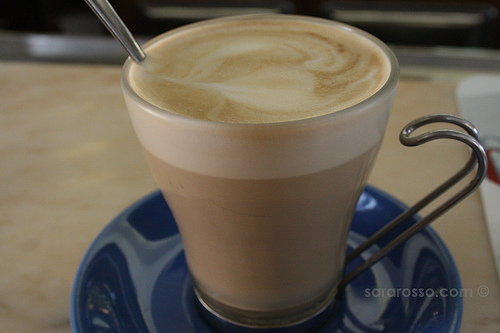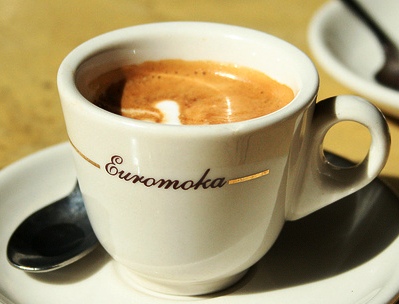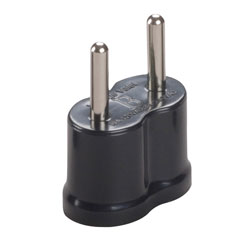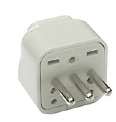|
|
Travel Tips for Italy
For lodging, meals, and tours, consult your favorite
guidebook. |
|
|
| |
|
|
Airports:
The international airport in Rome for
flights from and to the U.S. is Fiumicino, Lazio, code FCO.
It is also called Leonardo da Vinci airport; the other airport
in Rome is Ciampino. Information about
both of Rome's airports is at
Rome Airports. This site also includes information about transportation
to and from the airport.
My advice: if you're arriving directly from the US, you'll be jet-lagged,
sleepy, and juggling luggage through a strange airport: treat
yourself and take a cab, preferably one arranged by your hotel
or rental agency.
In case you're flying from Rome to another destination in Europe
or the world, the list of world airport codes is at:
World Airports.
|
|
|
| |
|
|
Coffee/Caffe: Italians down small coffee drinks several
times a day; they are small and, except in high-cost tourist areas,
inexpensive. Typically, you drink coffee at a "bar," which means
a coffee bar
not an American liquor bar, standing up. Don't be shy;
Romans are happy to serve you
and will help you navigate the choices. Remember, if you sit at a
table, you pay more.
Caffe (coffee) comes in only one size, not small,medium, or large. There are no
paper cups or take-out. Caffe bars don't serve "instant coffee" yet or
Mr. Coffee-type brewed or percolated coffee. Coffee drinks are never
served with the midday or evening meal, only
afterwards. |
|
|
| |
|
|
Espresso: Coffee or "caffe" in Italy always means
"espresso." It's a strong one-shot, comes in a small
ceramic cup (tazzina) with sugar ("zucchero,"
white sugar) and a small spoon. Maybe a slice of lemon on the side. Unlike in the U.S., Italian coffee is of uniformly high
quality across the city and across the country. For a weaker one-shot, order
it "Lungo;" for stronger, order "Ristretto." For two shots of espresso,
order caffe "Doppio."
|
|

Espresso. |
Caffe americano: this is a regular espresso with
more hot
water added after the tiny espresso is made. You can ask for "latte," meaning
milk, to add to it.
Latte: You won't find an American-type latte in Italy.
If you simply say "latte" you will get lukewarm milk, a children's drink.
What you want is either a cappucino or a caffe latte
macchiato . Caffe latte macchiato is hot steamed milk "stained" with a (wee)
bit of espresso, served in a glass or glass cup. |
|

Caffe latte macchiato |
A simple
caffe macchiato
is the opposite--it's espresso "stained" with a (wee) bit of
milk. Generally too strong for American tastes.
|
|

Caffe macchiato. |
Cappucino: espresso with some steamed frothy milk on
top. For many Americans, it's the closest to an American-style "latte."
Marrochino: Closest to an American "mocha": a
shot of espresso served in a glass demitasse with a sprinkling
of cacao and milk foam spooned on top.
Freddo: Espresso that is refrigerated after brewing;
served cold or at room temperature, but not over ice. This is not
a Starbucks-type "Frappucino."
HAG: decaffeinated. Pronounced "Aaahg."
Con Panna: with whipped cream.
Other drinks available at the Caffe: espresso with a shot of
liqueur, tea (te) and hot chocolate (cioccolato caldo). Some bars have additional specialty caffe drinks, including ice cream-and-caffe
drinks.
Moka pot: at home, Italians use a stovetop Moka pot.
Buy one made of aluminum-- it makes great coffee. It can sit on
top of either an electric or a gas burner. |
|
|
| |
|
|
Currency:
Italy is both in the European Union and uses the Euro as its
currency. Oanda, a useful Web site for calculating conversion rates is
at:
Currency Converter
Credit Cards, ATM cards, and Cash: Always have some
Euros in cash, in case your credit card is rejected. In
Europe cards are increasingly "smart" cards with an embedded chip rather
than the American-style magnetic strip on the back of the card. The
newer card readers in Europe can't read the older style US card,
especially on trains.
An
ATM machine in Italy is called a "Bancomat." Some smaller
merchants have a hard time giving change for a small purchase if
you use a 50 Euro bill. To obtain smaller bills, at the Bancomat/ATM
request a withdrawal that is not a multiple of 50: for example,
request 490 Euro rather than 500. The machine will give you the
valuable smaller bills.
If your ATM card is rejected, try again with a
smaller request. Most likely your request exceeded the bank's
daily allowance.
Notify your home banks and credit card companies of
your trip abroad before you leave the US. Otherwise, their
fraud units may assume your card(s) has been stolen and freeze
it.
Euro coins come in small denominations similar to the U.S.
penny, nickel, and dime. Keep your small Euro coins
in a separate coin purse; some restrooms require a
small tip for the attendant or supplies. |
|
|
| |
|
|
Closing times:
Many family-owned stores close for 1-2 hours in the middle of the day, then
reopen until 7 p.m.
This is not a siesta. Shopowners use this time for errands, child-care,etc. Some
stores close for the day at 12 noon or 1 pm on Wednesdays.
Others don't open on Mondays until the afternoon. Most stores, including grocery stores, are closed or have
very limited hours on Sundays, even in major cities and tourist
destinations.
National holidays: unlike in the U.S., some tourist sites
close. The Italian national holidays are: January 1,
January 6, Easter Sunday and Monday (dates vary), April 25, May 1,
Ascension Day (date varies), June 2, August 15, November 1, December 8,
December 25 and December 26.
Other holidays: The Vatican closes for lesser-known
Catholic holidays. Each town and city has local
holidays. Check with the local Tourist Information
Office for the latest information. |
|
|
|
|
|
|
|
Dates:
Italy uses the day/month/year format. For
example, Christmas Day (December 25) for the year 2013 is 25/12/13. |
|
|
|
|
|
|
Electricity:
Adaptors and converters:
Ungrounded or dual-voltage
American appliances need an ungrounded plug adaptor of two round prongs
(called Type B). |
|

Ungrounded plug adaptor, Type B |
Grounded appliances, which have
two flat blades and one round pin, need a grounded plug adaptor
(called GUI).
In addition to the plug adaptors, you need a converter to convert
American 110 Volts to European 220 Volts.
For information on adaptors and similar travel gear:
Walkabout Gear |
|

Grounded plug adaptor (GUI)
for Italy.
|
|
Internet Country Code:
.it (If you're using a laptop, check your "preferences"
to keep your access to
all those English-language Web sites you've bookmarked.) |
|
|
| |
|
|
|
Measurements: Italy follows the metric system.
Most useful to remember:
--Walking? a kilometer is .6 of a mile.
--Driving? a speed limit of 40 KM is 24 mph.
--Shopping? A kilogram, ubiquitous in grocery stores, is 2.2 pounds.
--Purchasing fabric? One meter is a bit more
than one yard—39 inches.
For precise
conversions, go to:
Conversions.
|
|
|
| |
|
|
|
Passport:
The expiration date on your passport needs to be
6 months beyond your date of entry into Italy. U.S. citizens don't need a visa to
enter Italy. |
|
|
| |
|
|
|
Telephones: Italy's Country
Code: 39.
There are
city codes of varying length. The local
number includes the "city" number: Rome is 06; Florence is 055,
etc.
Telephone city codes.
All Italian cell phone numbers start with
the "city" code
of 3 (not 03).
--To call Italy from the U.S., dial +011+39 + (local number).
--To call the U.S. from Italy, dial +001 + (area code) + (local number).
--To call a city in Italy from another city within
Italy: dial the local number without the “39” country code.
Example: you are in Florence and want to call number 555-678 in
Rome. Dial 06-555-678. Include the leading zero.
Even if you are in the same city,
include the city code. From Rome to Rome would be: 06-555-678.
--To
call Italy from elsewhere in Europe (except from the UK), dial +00+39+ (local number).
--To call another European country from
Italy, first find the
Country codes.
Then dial 00+(country code) + local number. France for example
is "33." You would dial 00+33+(ten digit French telephone
number).
Cell phones and smartphones:
This is a fast-changing subject. Many of the
older
US
cell phones won’t work.
For the newer ones, put it on
Airplane mode to avoid exorbitant international "roaming
charges." I take my non-US cell phone which I
purchased for about $30 in London, and buy a cheap SIM card
loaded with pre-paid minutes in whatever country I'm in. I use
my smartphone for its excellent camera and for internet
access; you can easily locate free Wi-Fi.
For
the latest options, check your favorite Web advice site
or call your cell phone provider.
|
|
|
|
Time Zone:
Rome
is 6 hours ahead of Washington, DC, most of the year. The exception:
Europe and the US change to and from Daylight Savings Time at
different calendar points. Find the time at:
Time and Date. |
|
|
| |
|
|
Temperatures:
For weather,20 degrees Celsius is 68 Fahrenheit, while 30
degrees C. corresponds to 86 degrees F. Most Americans are
comfortable within these ranges.
For a quick estimate of the Fahrenheit equivalent, double the
Celsius number and add 25. For more precise conversions, go to:
Conversions.
On an oral or health thermometer, the equivalent to 98.6 F
(normal body temperature) on a U.S. thermometer is 37 C. |
|
|
|
|
|
|
Washing
Machines: European machines use less water and clean clothes well.
--The water in Rome has
calcium and other hard minerals; washing machines require more maintenance and
de-scaling from mineral build-up. To each load, add about
6 TB of an anti-calcere powder. Brands such as Calgon are
found near the washing machine laundry products in the
supermarket.
--The Italian word for laundry detergent is "Lavatrice."
For less mineral build-up, use liquid, not powdered,
detergent. European washers are front-loading. Use much, much
less detergent than you would for the top-loader kind typically
found in the U.S., or you will soon have suds overflowing onto
the floor.
--The cycle time is longer than
typical of
a US washer: usually 60-90 minutes. The setting for normal
wash is "Sporco normale."
-- Some washers have a
built-in dryer, which takes an incredibly long time to dry
clothes: most Italians dry their laundry on clothes lines.
--Once the cycle is complete, the machine door will NOT release
immediately. The machine evidently needs to sit a while and
think. If you try and force open the door, you will jam it.
(Then how you will get your clothes? ) |
|
|
| |
|
|
Weather: Useful Web sites:
http://www.weather.com/ or
http://www.wunderground.com/
To find weather conditions at the Rome international airport,
look for Fiumicino, Lazio. The word "airport" doesn't appear. |
|
|
| |
|
|
Blogs
and Web sites with interesting tips:
MsAdventures
Slow Travel
|
|
|
| |
|
|
| You may contact
me, Nancy Padgett, at
NJPadgett@gmail.com |
|
|
|
|